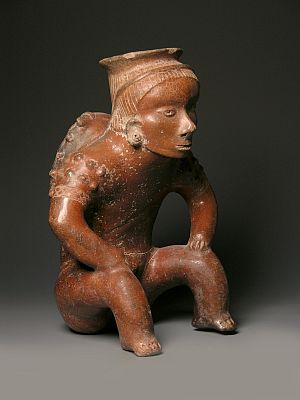Puerto Vallarta, Jalisco, Mexico - Imagine, if you will, ships loaded under the weight of oyster shells and vessels traveling the Pacific Ocean carrying textiles, wood, ceramics, copper, and tin and you might think such sights not unusual at all. But, imagine that these ships are made of balsa wood and the oysters are a variety of pink, red, and white spondylus oyster found only in the depths off the coast of west Mexico's state of Colima.
Imagine too the papyrus vessels carrying goods up and down the coast every six months from and to the Pacific Mexican coast, from and to what is now Colombia, Ecuador, and Peru. Having had such a vision you would in fact be recounting the three-thousand years of trade between the territories of the Nayari (mostly now in the western Mexican states of Nayarit and Jalisco), Purépecha in Michoacan, and Chichimec in Colima.
Perhaps the most striking cultural reality of western Mexico is its practice of ceremony in the form of great parties where people shared vast quantities of tamales, zapote negro and blanco, mamey, amaranth, camote, squash, capomo, and varieties of fish, deer, and the occasional dog. All this and more celebrating a god for weeks and depicting the event in groups of clay human figurines holding fruits, cups of fruits and pulque, with little buildings, and a clay floor-"ceramic photos." The detail of these figures and other hollow ceramic figures help to tell the stories of the ancestors of modern indigenous peoples in west Mexico.
The economies of indigenous west Mexico and indigenous northwest South America and the Andean Spine were based on the arts and crafts of ceramics, fishing, the reuse of spondylus shells, ceremonial parties, weaving of textiles, propagating amaranth, squash and beans, careful use of wild plants and animals for food and medicine, and trade with neighbors and across the seas.
Thousands of years of civilization continue in western Mexico even as a few generations of newcomers have joined in the region. The great "Nayari, Xalisco, Chichimec, and Purépecha" societies living today have a deep heritage in this land of west Mexico and in the indigenous societies of Columbia, Ecuador, Peru, and Bolivia. The peoples, cultural traditions and healing practices are to be seen everywhere; to think it has disappeared is a myth. Rather, these traditions are waiting to be made more visible to the naked eye.
With all of this social, economic and political activity up and down the Pacific Coast for several thousand years, the indigenous peoples of west Mexico made a small footprint on the environment, disturbing it very little. Industrial societies described as "developed" have much to learn from the truly developed indigenous societies of Mexico's Pacific coast.
 Dr Rudolph Ryser is a Professor of International Relations, the Executive Director of the Center for World Indigenous Studies, an international non-governmental Indigenous organization, and was awarded a Fulbright Scholar grant to conduct research in western México and deliver lectures at the Universidad del Valle de Atemajac (UNIVA) in Puerto Vallarta, México during the 2011-2012 academic year.
Dr Rudolph Ryser is a Professor of International Relations, the Executive Director of the Center for World Indigenous Studies, an international non-governmental Indigenous organization, and was awarded a Fulbright Scholar grant to conduct research in western México and deliver lectures at the Universidad del Valle de Atemajac (UNIVA) in Puerto Vallarta, México during the 2011-2012 academic year.



